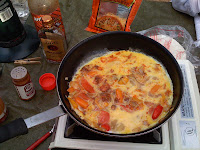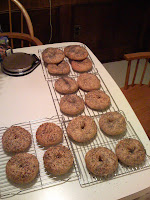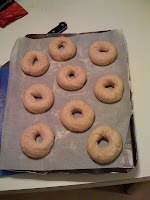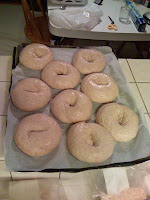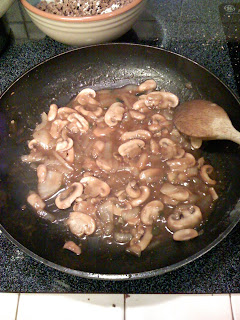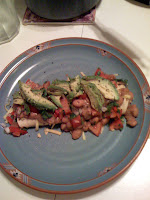
A staple of my diet for the past 15 years has been "Beans & Tortillas," ie, burritos. Up to once a week, I would heat up a couple of cans of Trappey's jalapeno pintos (or, the Ranch Style brand, or Whole Foods' 365), add a bunch of comino, some chopped onions, and fresh ground black pepper. I'd heat a couple of tortillas (or even fry up some chalupas) add grated cheddar and jack cheese, and roll it all up with a pico de gallo or fresh avocado topping. This is one of our all-time favorite meals.
Nowadays, I eschew the canned beans and roll my own, so to speak. When my stocks run low, I buy a pound of dry pintos and spend a couple of days making some damn good beans.
Ingredients1 pound pintos (dry)
one smoked poblano pepper
2 tablespoons comino (cumin)
1 tablespoon chili powder
1 tsp olive oil (or a bit of bacon or salt pork)
several turns of fresh ground pepper
1 tsp salt
tortillas or cornbread, cheese, and toppings
Dry beans can be intimidating for the novice. This isn't something you can decide to make one night. I always buy a bag full when I know I'm running out, and just start this recipe up while Im in the middle of something else in the kitchen. I especially enjoy doing this on a Wednesday or Thursday night, giving me the opportunity to get the batch going during the day Saturday, making a nice Saturday dinner or afternoon snack.
So, I've just spilled the beans - this recipe takes a couple of days. Deal with it, hombre.
Put the beans in a bowl with at least 25% room left, and cover them with water. Over the first few hours, you'll have to monitor and add water to keep them covered. They'll suck up that water and expand pretty quickly over the first few hours. I had a few too many beans in my bowl the last time, and the guys on top were not covered with water and sprouted. That didn't save them, as I ate 'em anyway.
Up to three days later, rinse the beans and prepare for cooking. On the second day, you'll see a little fermentation going on. That's pretty cool. The third day is even cooler. All that is OK. It may look a little funky, but it's a bit less musical in the end if you get my drift.
OK, so what the hell do we do now?
First of all, I hope you didn't shy away from the smoked pepper. I like to throw a poblano in the smoker the week before I know it's bean time. Since I'm normally smoking some meat or fish about once or twice a week, I don't have to fire that bad boy up just for one chipotle pepper. I can put that in the fridge and it's good to go at any time over the next week. When I'm ready to use it, I peel off the waxy skin, stip out the seeds, and chop it up. If you don't want to mess with that, use some canned chipotle peppers or just chop up a fresh jalapeno. To me, this is the ingredient that makes these the best beans I've ever had, so try it out if you can.
OK, now you can start cookin.'
Rinse the beans, throw them in a stock pot, and add all the ingredients. I just ball-parked the comino / chili powder usage. I'm used to just shaking the crap out of that stuff until it looks right. Also, some chili powders are hotter than others, so I vary the usage of that based on taste. It's hard to use too much comino, though. That's about the best spice in the world.
Bring all this stuff to a boil and then cook it on low for at least four hours. On my electric stove top I move the temp from 2 to 1 to Warm and back up the scale. You need to go higher than W for most of the cooking, but you dont want to be burning the stuff, either.
I roll this up in warmed tortillas with grated cheese, and top said tortillas with aforementioned veggies.
A full batch makes about four meals (for two). I store two or three batches in 1 qt containers in the freezer, so I can quickly deploy a fast dinner without having to break out the can opener.
enjoy!

